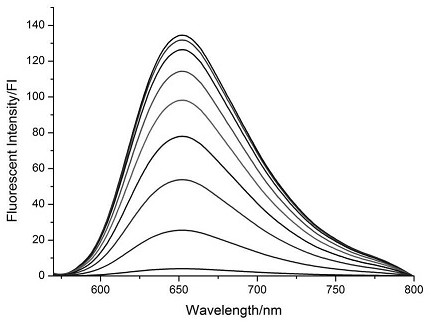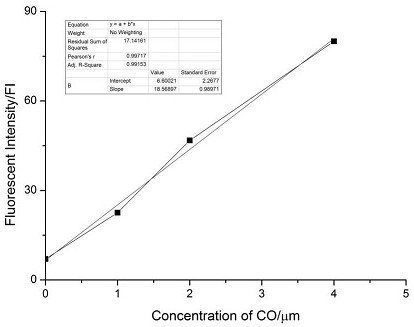Novel fluorescence detection reagent and technology for quantitatively detecting in-vivo and in-vitro CO
A fluorescence detection and reagent technology, applied in the field of analysis and detection, can solve the problems of limited large-scale use, weak tissue penetration ability, short emission wavelength, etc., and achieve strong practical application value, low cytotoxicity, and high specificity
- Summary
- Abstract
- Description
- Claims
- Application Information
AI Technical Summary
Problems solved by technology
Method used
Image
Examples
Embodiment 1
[0029] Synthesis of compound 3
[0030] Compound 1 (1.56 g, 5mmol) and compound 2 (1.30 g, 5mmol) were dissolved in 5mL of concentrated sulfuric acid, and at 90 o Heat to reflux at C, monitor by TLC until the reaction is over, take down the reaction, cool to room temperature, pour into ice water, and add 1mL perchloric acid, a large amount of precipitation can be seen, suction filter, collect, wash the filter cake, and recrystallize with ethanol , 1.50 g of dark green solid can be obtained with a yield of 55.7%.
[0031] Synthesis of Compound 4
[0032] At room temperature, compound 3 (1.34 g, 2.5 mmol), hydrazine hydrate (1.64 mL, 25 mmol) and BOP (1.13 g, 2.6 mmol) were added into a 50 mL round bottom flask, and 10 mL of dichloromethane was added to dissolve. The reaction system was stirred at room temperature and monitored by TLC until the reaction was completed. The reaction was removed, and the solvent was removed under reduced pressure. After purification by column ch...
Embodiment 2
[0036] Response of Fluorescent Detection Reagents to Different Concentrations of CO
[0037] Prepare 5 mL of an aqueous solution with a concentration of 1 mM CO and the fluorescence detection reagent prepared in Example 1 with a concentration of 1 mM as backup. Dilute with PBS buffer solution (10mM, pH=7.4), adjust to the concentration of the probe compound in the solution is 10 μM, and the concentration of CO is 0 μM, 1 μM, 2 μM, 4 μM, 7 μM, 10 μM, 15 μM, 20 μM, 30 μM, After incubation at room temperature for 20 min, the fluorescence spectra of different systems were tested in 10 mm cuvettes ( figure 1 ). Calculate the fluorescence intensity in each system, and establish a standard curve of fluorescence intensity and CO concentration. Such as figure 2 As shown, when the concentration of CO is in the range of 0-4μM, the fluorescence intensity has a good linear relationship with the concentration of CO, the regression linear equation is y=18.56897x+6.60021, the linear corre...
Embodiment 3
[0039] Selectivity of Fluorescent Detection Reagents for CO
[0040] Prepare 5mL PBS aqueous solution of various conventional ions and amino acids with a concentration of 50mM and the fluorescence detection reagent prepared in Example 1 with a concentration of 1mM as spares. Dilute with PBS buffer solution (10mM, pH=7.4), adjust to the concentration that contains probe compound in the solution and be 10 μ M, the concentration of CO is 30 μ M, and O 2 - , OH, H 2 o 2 , HOCl, ONOO - 、CN - 、H 2 The concentration of S and GSH was 100 μM. After incubation at room temperature for 20 min, the fluorescence spectra of different systems were tested in 10 mm cuvettes ( image 3 ). The results showed that other analytes had almost no effect on the fluorescence of the fluorescent molecular probes, but the addition of CO significantly enhanced the fluorescence of the fluorescent molecular probes.
PUM
 Login to View More
Login to View More Abstract
Description
Claims
Application Information
 Login to View More
Login to View More - Generate Ideas
- Intellectual Property
- Life Sciences
- Materials
- Tech Scout
- Unparalleled Data Quality
- Higher Quality Content
- 60% Fewer Hallucinations
Browse by: Latest US Patents, China's latest patents, Technical Efficacy Thesaurus, Application Domain, Technology Topic, Popular Technical Reports.
© 2025 PatSnap. All rights reserved.Legal|Privacy policy|Modern Slavery Act Transparency Statement|Sitemap|About US| Contact US: help@patsnap.com



